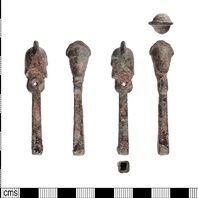
Viking Objects
Copper-Alloy Toilet Implement (LIN-756E6A)
This early medieval socketed anthropomorphic object possibly depicts the Norse god Odin, who wears a bird-headed helmet or headdress. This object belongs to a group of similar figurines, all with bird-headed helmets or headdresses, which have been found in England, Sweden, Gotland, Denmark, Russia, and Belgium. Evidence from cemeteries demonstrates this type of object is strongly associated with women, and is probably an import from Sweden dating to the later seventh century, demonstrating contacts with Scandinavia before the Viking Age. While the exact function of this object remains unclear, parallels suggest it is perhaps a toilet implement.
Read More
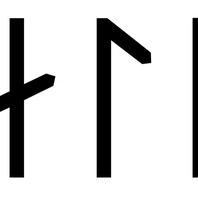
Viking Names
Ali/Alli
It is not possible to determine whether the names in Lincolnshire derive from Áli or Alli so all information for both names appears on this page. Áli is a diminutive name and occurs in Old West Scandinavia but it is not really frequent although it occurs as the first element of Norwegian place-names. It also appears in a few Danish place-names, but is not found in documents except for the Latin form Anulo. Alli is a short form of a compound name in Alf- or Al-. It does not occur independently in Old West Scandinavian but is found in a few Norwegian place-names. There are several instances in Old Danish including Latin Allo and a number of runic examples in both Denmark and Sweden. Áli or Alli is the first element of the place-names Aylesby, Althorpe, and Ailby in Lincolnshire.
Read More
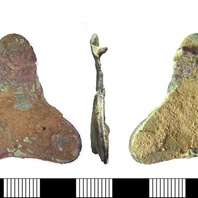
Item
Trefoil Brooch (LEIC-BD8163)
Trefoil brooches were characteristically Scandinavian women’s wear. However, many examples found in the East Midlands were probably made in the Danelaw, and may have been copies of Scandinavian styles, instead of being imported from Scandinavia. The decoration on this example features a foliate design. For more information on Scandinavian jewellery in England check out our blog: Brooches, Pendants and Pins: Scandinavian Dress Accessories in England.
Read More
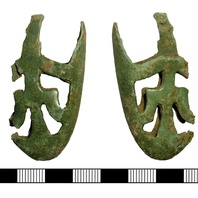
Viking Objects
Scabbard Chape (NLM-5BD697)
The incomplete openwork tongue-shaped front plate of this chape is decorated with at least six asymmetrical apertures and resembles similar chapes with ‘Birka Falcon’ decoration.
Read More
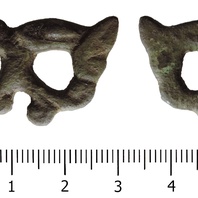
Viking Objects
Zoomorphic Mount (DENO-7E523C)
This example of a copper-alloy openwork zoomorphic mount, strap fitting or harness fitting, is decorated with the head of an animal in profile.
Read More
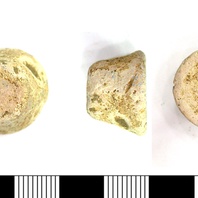
Viking Objects
Lead-Alloy Gaming Piece (LEIC-F39697)
This and similar pieces have also been interpreted as weights although the gaming-piece interpretation is more secure. Pieces like this would have been used to play hnefatafl and/or Nine Men’s Morris, both of which are known to have been played in Scandinavia in the Viking Age.
Read More
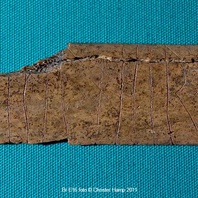
Viking Objects
Rune Inscribed Rib (LCNCC : 1999.103.104)
Runes were used not only for monumental inscriptions, or to mark ownership of valuable objects, but also in more informal contexts. In this case the animal bone suggests an after-dinner pastime after a good meal in the Anglo-Scandinavian trading centre of Lincoln. The runes read ——l × hitir × stin × … Only two words of the Old Norse inscription can be read with certainty, and even so they are ambiguous. One possible interpretation is ‘[someone] is heating a stone’ the other is ‘[someone] is called Stein’. The bone is fragmentary, but the inscription may never have been intended to make much sense. The object dates from around the 10th century. It is one of only three runic inscriptions from the East Midlands.
Read More
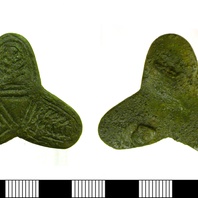
Viking Objects
Trefoil Brooch (LEIC-A43E83)
Trefoil brooches were characteristically Scandinavian women’s wear. However, many examples found in the East Midlands were probably made in the Danelaw, and may have been copies of Scandinavian styles, instead of being imported from Scandinavia. This example was found near Lincoln. For more information on Scandinavian jewellery in England check out our blog: Brooches, Pendants and Pins: Scandinavian Dress Accessories in England.
Read More
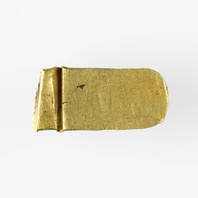
Viking Objects
Hack-gold (CM.1800-2008)
This rounded ingot terminal was cut from a larger rectangular ingot. Though rarer than hacksilver, this gold ingot formed part of the bullion currency used by Vikings in England and may be associated with their winter camp in Torksey.
Read More
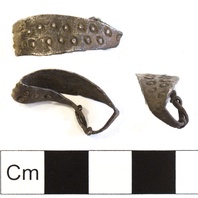
Viking Objects
Stamped Finger Ring (NCL-90DD85)
A silver finger ring made from a sheet of silver cut to size featuring circular punched decoration. Rings like this with knotted ends are typically Scandinavian.
Read More
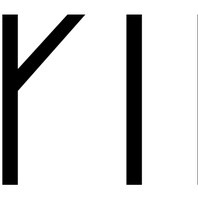
Viking Names
Viking
The male name Víkingr is recorded in some eighteen Viking Age runic inscriptions from Denmark and Sweden, and there is evidence it was used in Norway in the Viking Age and even later. It probably derives from the appellative (common noun) víkingr, the meaning of which varies through time and in the different sources. In Lincolnshire, the place-name Wickenby is formed of either the name or the appellative plus Old Norse -by ‘farm, settlement’. In Leicestershire, the element is combined with Old English tun in Wigston Magna (while Wigston Parva has a quite different origin), and is thus a hybrid name. In this case, the parallels with other hybrid names suggest that the personal name is more likely than the appellative as the first element.
